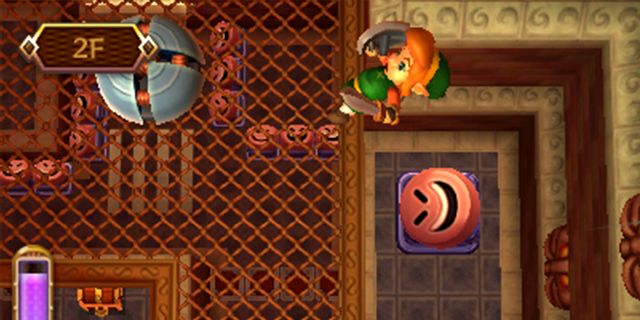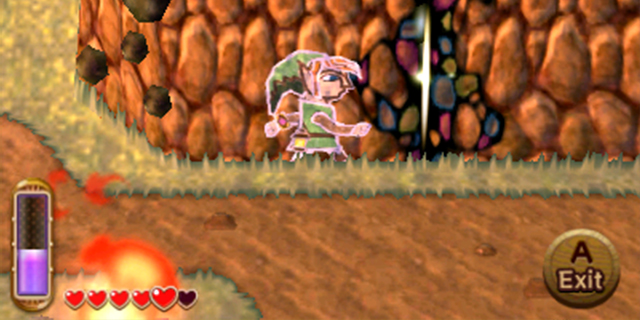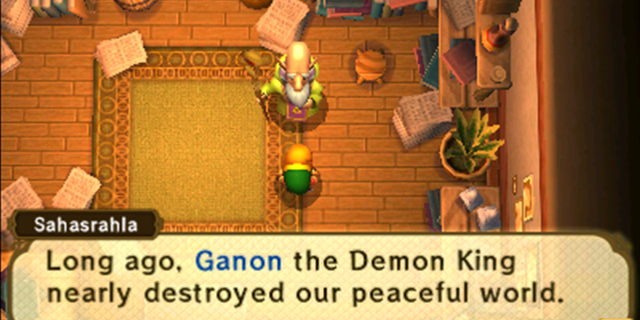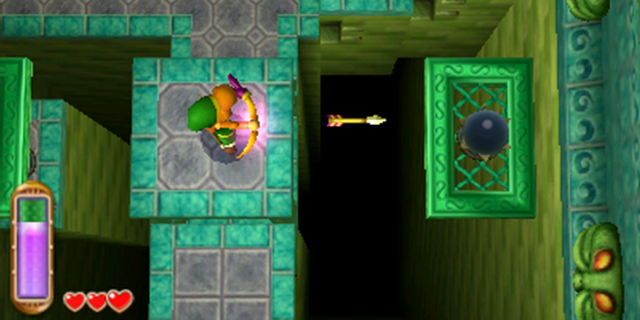
The Legend of Zelda: A Link Between Worlds is essentially a direct sequel to A Link to the Past, set in the same world and with many callbacks to one of the finest games ever made. Many of the mechanics, such as the constant switching between Hyrule and another world — in this case the kingdom of Lorule (a bit of wordplay also made by The Wonderful 101, oddly) — make a return in some form or another, but Link Between Worlds adds some modern twists to the classic Zelda gameplay.
The obvious new trick in Link’s bag is the ability to merge into walls as a sort of living graffiti. This is useful for crossing chasms and slipping through narrow spaces Paper Mario-style, but it also has some surprising defensive uses as well. I find it amusing that the first Zelda title made specifically for the 3DS has becoming two-dimensional as its big gameplay hook, but it works well once you get used to the fact that you can do it. In a brilliant artistic touch, the normally robust background music becomes tinny and flattened when you merge, helping to sell Link’s unusual physical condition. You can only stay merged for as long as your stamina meter holds out, but that is usually a pretty generous timer that replenishes fairly quickly.

The stamina meter comes into play with the other, more risky innovation LBW makes to traditional Zelda play: renting items. While you can still occasionally find useful tools in dungeons, most of your toys (including series mainstays like the bow, boomerang and bombs) will be rented from an odd bunny-suited gentleman named Rovio. Using any one of these items reduces your stamina meter, but that’s the only other cost involved. You no longer have to worry about running out of bombs, arrows, magic or any other consumable, but the counter to that is that using any one item too often will leave you without access to all of your (stamina-using) items temporarily. The catch is that you can only use the items you rented until the next time you fall in battle, at which point they are all returned and you have to re-rent them. Being resurrected by a bottled fairy does not count against you, thankfully.
The fact that (nearly) every item in the game is available to you for a mere handful of rupees right at the beginning really opens up your options. You can basically take on the game’s dungeons in any order you choose. If a dungeon requires extensive use of a specific item, that item will be indicated on pillars in front of the entrance and you can prepare accordingly. Most dungeons have a weathervane near the entrance, allowing you a quick warp between it and the item shop if you need to gear up. It’s an interesting design choice but feels a little under-developed. Then again, I only died twice and was never short of rupees, so the drawbacks were rarely relevant to my experience. Later on in the game you can purchase the items permanently, which allows you to upgrade them (if you undertake the only significant side quest), although they still use the stamina meter.

While merging is a neat ability and renting items is an interesting twist, where Link Between Worlds really shines is in level design. The Hyrule overworld looks amazing, and is almost a one-to-one recreation of the LttP map. Its dark counterpart Lorule bears some similarity to the Dark World, but is unique in its own ways. Then there are the dungeons. The highlight of any Zelda game are the dungeons, and Link Between Worlds has both a lot of them (around a dozen) and ones that are filled with interesting puzzles. My favorite is the Dark Palace, which uses light and shadow in some truly devious ways, but each one has its own unique charms.
The 3D aspect of the game isn’t quite as played up as it could be, which is good news for 2DS owners, but it does aid in a few areas like a baseball-like minigame or tricky jumps on to moving platforms. Mostly it’s just used to make the game look like a prettied-up version of the SNES title, with everything having real depth instead of merely being detailed 16-bit sprites, and making flying or hopping enemies really pop. (Speaking of which, you won’t soon forget your first 3D encounter with a Wall Master.)
I wonder if anyone who hasn’t experienced Link to the Past can fully appreciate Link Between Worlds. After so many epic Zelda quests in recent years, some might complain that you can complete this one in well under 20 hours. However, I have clear memories of replaying LttP from start to finish in the space of around 12. What makes both of these games efficient in their run times is a noticeable lack of padding. There isn’t much in the way of tutorials, there isn’t a lot of chatter with copious NPCs, there’s just the one sidequest to speak of and the overworlds are small enough (and filled with enough warp points) that you are never wandering around aimlessly over expansive vistas while trudging from point A to point B. It really feels stripped down to just the essentials, something that could not be said about Zelda games for some time now. And yet it never feels lacking in any noticeable way. Completing the quest also gives your new save files access to Hero Mode, in case the first quest wasn’t enough of a challenge for you.

While I greatly appreciate how Link Between Worlds pays homage to its predecessor, there is one area in which I wish it were a little more modern: save points. You can only save at weathervanes, spaced strategically over both overworlds but nowhere to be found in dungeons. Oh, you can quit playing any time you want, but you will lose any progress since your last trip to one of those warp points. Not having any kind of quick-save function is inexcusable on a handheld game, as sleep mode has its limits when your battery is running low.
The other main problem is, ironically, an area where it does embrace its modern nature instead of emulating an SNES game. Movement is controlled by the circle pad, with the D-pad allowing you to pan the camera to scout ahead, but the game is still very much laid out on a straight grid when it comes to things like narrow walkways or moving platforms. I fell into way too many pits and off too many narrow walkways (often also into a pit) thanks to the less-rigid nature of circle pad movement, and wished many times that these functions could be reversed. If you ever find the treasure cave that requires you to make precision Pegasus Boots dashes, you will see this drawback in all of its glorious frustration.
Still, these are minor quibbles. A Link Between Worlds is one of the finest titles I’ve played this year and will be remembered fondly, even among the stacked Zelda pantheon. Is it the best in the series? That will be debated for some time, which is a good problem for any game to have.
Pros: Lives up to the impossible pressure of being a sequel to one of the best games ever made
Cons: Circle pad movement is too imprecise, lack of quick-save



















